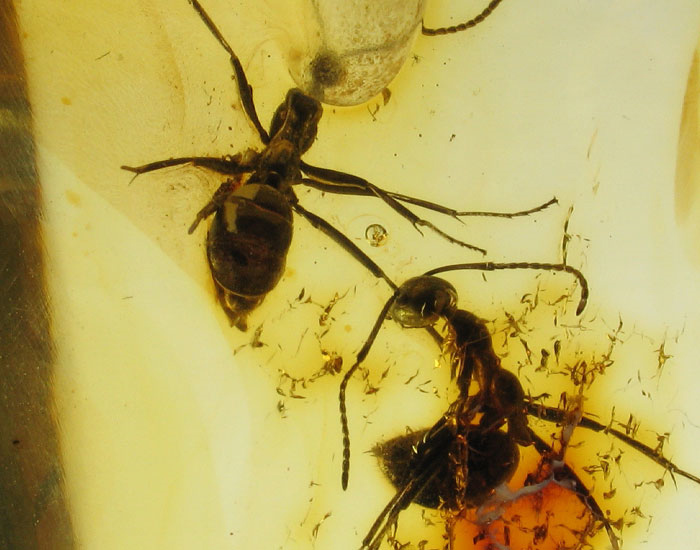Here's something unusual for the well-financed collector: Paraneuretus, an extinct genus from a nearly extinct subfamily of ants. This pair of fossilized worker ants is selling on ebay today for over $400. Out of my budget for these sorts of things.
Most amber ants up for auction belong to common extinct species: Azteca, Tapinoma, Camponotus and so forth, usually from the Dominican or Baltic amber deposits and pertaining to extant genera. This is the first aneuretine I've seen.
What's interesting about these ants? Well, they're one of those neither-this-nor-that fossils that are intermediate between groups of modern ants. Aneuretines have a single petiolar node and a body structure much like the modern subfamilies Dolichoderinae and Formicinae. But unlike either of those, Paraneuretus retains a stinger. It's like a proto-dolichoderine before the ancestral stinger was lost in favor of more derived chemical defenses.
A single aneuretine persists today: Aneuretus simoni, a small and probably endangered species from Sri Lanka. Genetic analyses of that species show it to be sister to dolichoderines, as one would expect. What is less clear is where fossils like Paraneuretus fit. They might be relatives of Aneuretus, but their similarity might just be an artifact of retained ancestral traits, with Paraneuretus genealogically closer to the dolichoderines. In any case, it is a fascinating fossil and a glimpse at an earlier ant body plan only rarely seen today.
By the way, if any of you end up buying these ants I urge you to consider donating the specimens to a museum where they will be available for scientific research. Other specimens do exist, but these are in beautiful condition.
- Log in to post comments



Yes, $420 is a little more than what I have in my pockets right now... :(
Hmm, I wonder if we could band together to buy them for a museum. I'd be happy to throw in a few Euros.
good idea
I'll chip in the extra if the seller turns it into a pendant...
Not sure what museums are paying (or have paid) for such things, but $420 for these specimens seems like a good buy for a museum with a bit of discretionary cash on hand.
It's even cooler that the ants seem to have been fighting when they were fossilized. How long ago did the aneuretines and dolichoderines diverge?
They are beautiful.I hope they find there way to a 'home' when they can been seen by many.
Aneuretus IS a dolichoderine and never diverged from dolichoderines. This results from published morphological (no salient apomorphies) and genetic analyses.
The ancestor of Aneuretus simoni and the extant dolichoderines is inferred to be about 90 million years old (Brady et al 2006). The modern dolichoderines are probably closer to the K/T boundary in age, and as these amber fossils are from about 40 million years ago they're too young to be from a dolichoderine ancestor species themselves.
agnostic's point is a fair one: once we consider the fossils, it's not clear that Aneuretinae needs to be separate from Dolichoderinae, as dolichoderines may be aneuretines that have lost the sting and made a few adjustments to the abdominal morphology.
Taking the sister-group relationship between aneuretines and what is currently considered dolicoderines for granted (as shown in the best phylogenies we have so far), I think this is one of those cases in which where do we draw the "subfamily" line needs to be done on the basis of salient synapomorphies rather than just tree topology.
On that account, current dolichoderines are well circumscribe by a major anatomical rearrangement of the gastral architecture. This involves the transverse folding of the pygidium on its midline more than 90o, with the result that the opening of the pygidial gland becomes the posterior-most part of the body. Even the direction of the pilosity is inverted on this plate (the fact that only four plates in the gaster are visible on dorsal view is an accident, i.e., it doesn't have any function).
Only Technomyrmex lacks this feature among dolichoderines. Not only does this has to be explained as a "reversal" given the position of this genus within dolichoderines, but on close inspection (that is, scanning electron microscopy as I have done), the pygidium has the appearance of an underdeveloped structure that doesn't resemble unfolded pygidia in ants.
There is another very striking morphological synapomorphy, present on all adult dolichoderines castes, that pertains the petiole and it's unique among ants (and Hymenoptera for that matter), but it is unpublished and I won't burn it here.
Now, Aneuretus does have an unique petiole with a tubular peduncle that bends upwards immediately after its place of articulation with the propodeum. It also has a large groove on the anterior surface of the foretibia, again, unique in ants (oh well, I just burned that one). Unfortunately fossils like the ones pictures above have a more generalized petiole, and someone has to check for the groove on those.
Both groups warrant subfamily status in my opinion.
If we consider just the extant groups, I agree that we have plenty of grounds for retaining two subfamilies. But as usual the fossils are the problem, the primary challenge to a monophyletic Aneuretinae.
The extant Aneuretus has plenty of distinguishing features, but even the petiolar shape of the fossils is ambiguous, especially if one considers that the long anterior peduncle might be pleisiomorphic, as Nothomyrmecia and Tetraponera seem to indicate. Not that I've looked at them in any detail, but my impression is that these fossils may just as likely be stem-group dolichoderines, or even stem group dolichoderomorphs.
THey didn't sell at $419.99 so they've been relisted -- now at $499.99